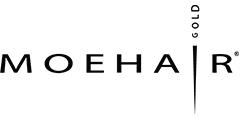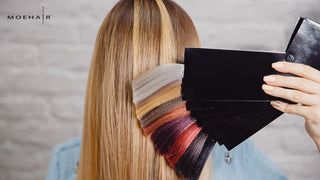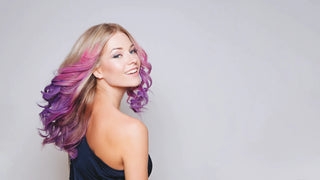 Table of contents
Table of contents
Trying a new hair color is always fun. It's remarkable how the slightest change to your hair color can elevate your confidence and revamp your persona. Celebrities flaunt the trendiest hues repeatedly; now it’s time you take a cue from your stylist and get a colorful makeover.
While coloring your hair is refreshing, decoding the appropriate color can be challenging. If you are confused about what hair color is best for your hair, skin tone, or hair type, let’s simplify the hair coloring chart for you. Our comprehensive guide clubs all the necessary information - hair color levels, hues, and choosing the right shade.
Introduction to hair coloring chart
A hair color chart visually displays a variety of hair shades, ranging from light to dark, including variations and undertones. Understanding the hair color shades is imperative for professionals and individuals who want to change or maintain their hair color. The hair coloring chart includes color options, shades, and compatibility with different hair types.
Also Read - Guide to Semi Permanent Hair ColorsDifferent types of hair coloring chart
- Basic shade chart: This chart displays colors, usually categorized into warm, cool, and neutral tones. It helps you identify your current shade and choose a similar or slightly different one.
- Color wheel: A color wheel illustrates how different colors interact. It helps understand the color theory and select complementary or contrasting shades.
- Swatch book: A swatch book provides a physical sample of hair colors. It helps professionals show their clients how a specific shade will look on hair. Moehair’s hair color swatch book provides detailed hair shades and tones information.
- Digital charts: With the advent of technology, many brands now offer digital tools and apps that allow you to virtually try on different hair colors to find the perfect match.
The Anatomy of a Hair Coloring Chart
The basic knowledge of hair color helps in understanding the hair coloring chart . Your natural hair color is determined by the combination of pigments in your hair. It includes eumelanin (which produces black and brown shades) and pheomelanin (which makes red and blonde shades).
Hair Color Levels Demystified
Hair colors are also categorized by levels, determined by how dark or light your hair color is. According to the coloring charts, the levels range from 1 to 10, where level 1 represents black and level 10 represents the lightest blonde. Understanding the level of your natural hair color is effective in choosing the right shade. Whether you color your hair at a salon or opt for a DIY option at home, understanding the hair color level helps you pick the right shade.
Understanding hair color tones
By now, we have already learned that natural hair color combines black, brown, blonde, and red shades. Formulating the hair colors precisely focuses on the tones it aims to achieve. The color tones include warmer, cooler, and neutral tones. The warmer tones include hues like peach, golden, or yellow, and cooler tones incline towards hues like blue or pink. Neutral tones lean towards brownish-to-beige colors.
Choosing the right hair color
When picking the right hair color, it is crucial to consider a few factors. Understanding color therapy and choosing a complementing color depends on the following:- Skin tone- Warm undertones in your skin pair well with warm hair colors, while cool undertones complement cool hair colors.
- Eye color- It might be surprising, but it also influences your hair color. For example, warmer tones look better on people with blue eyes, while cooler tones complement people with green eyes.
- Lifestyle- Consider your lifestyle and how much you will commit to it. Some colors require frequent touch-ups, while others are low-maintenance.
- Personal style- Your style and fashion preference should also guide your choice. Pick the color depending on your choice, whether you want a bold or subtle makeover.
Understanding hair color tones and levels helps you find the right match for your hair. Depending on the above-mentioned factors, find the right shade from the hair level chart.
You might need a few things to start the process of DIY hair coloring at home. Keep the following things handy - a mixing bowl, hair color, developer, gloves, applicator brush, clips, old towel, and a time tracking device like a watch. You don’t need to worry about the essentials for coloring at the salon.
How to start using the hair coloring chart?

- Identify your current hair color - Start by finding your current hair color on the chart. This serves as a reference point for your desired change.
- Explore color variations - Look for shades that are either slightly lighter or darker than your current color to bring a difference if you are looking for subtle change. Also, make sure to pick a color that fits right with your skin tone.
- Decide the coloring technique - Once you have decided on the color, next is picking on the desired technique. Options often include highlights, lowlights, or all-length coloring. Consider balayage if you love natural and effortless highlights. This method involves hand painting the strands with the color, leaving a subtle, sun-kissed effect.
- Book professional consultation - If you are still confused about what color to choose or technique to follow, it’s best to seek expert guidance. Consult a professional colorist for the same.
Understanding the different shades of colors
 While the shelves are rife with colors, most of them have a minute difference in shade. Here’s a summary of some of the standard hair colors.
While the shelves are rife with colors, most of them have a minute difference in shade. Here’s a summary of some of the standard hair colors.
Black hair:
It includes jet black and natural black. They look similar but slightly vary in terms of gloss. Jet black color is the darkest shade of black and is glossier, while natural black is softer with subtle brown undertones.
Brown hair:
-
Dark brown: A deep and rich brown color or brunette, often close to black
-
Medium brown: A warm and versatile brown shade, neither dark nor light.
-
Light brown: A lighter shade of brown with noticeable warmth and often golden undertones.
Blonde hair:
-
Platinum blonde: It is an extremely light color with tints of whitish silver.
-
Ash-blonde: This is a pale blonde shade with hints of gray or silver.
-
Honey blonde: It is a warm, golden shade with honey-like tones.
-
Strawberry blonde: This is a reddish or coppery blonde, often resembling the color of strawberries.
Red hair:
-
Copper red: A bright, vibrant red with coppery solid tones.
-
Auburn: A rich, reddish brown color with a mix of red and brown hues.
-
Burgundy: A deep, purplish-red shade with hints of violet.
Gray and Silver Hair:
-
Silver: Hair that has turned shiny, metallic silver, or gray.
-
Salt and pepper: A mix of dark & gray or silver strands, creating a peppered effect.
-
Steel gray: A cool, dark gray with a steel-like sheen.
Unconventional colors:
-
Pastel colors: They are soft, muted shades like pastel pink, lavender, or mint green.
-
Vibrant colors: Bold and bright colors like neon green, electric blue, or fiery red.
-
Rainbow colors: Multiple colors blended, creating a rainbow effect.
Addressing Hair Color Issues - How to Take Care?
 Coloring is cool, but it comes with many issues that need addressing. Hair colors can only stay salon-fresh if you dig down the issues and address them. Here are a few common issues:
Coloring is cool, but it comes with many issues that need addressing. Hair colors can only stay salon-fresh if you dig down the issues and address them. Here are a few common issues:
- Fading color- Subsequent hair wash often starts fading the hair color. Switch to color-safe shampoos and conditioners that are formulated for colored hair. Wear a sun cap or hat before stepping out to limit direct sun exposure.
- Uneven color- If the hair color is not evenly distributed during the application, it leads to uneven tone. Always follow the recommended processing time and avoid over-layering during touch-up.
- Unwanted tones- To neutralize unwanted tones (e.g., brassiness in blonde hair), use a color-correcting shampoo and conditioner. The purple shampoo helps eliminate unwanted brassiness.
- Patchiness- If you have patches of uneven color, consider consulting a professional stylist for color correction.
- Allergic reaction- Doing the patch test before proceeding with any hair coloring product is always suggested.
How do you maintain hair color for a longer time?
 Maintaining hair colors depends on several factors, including color type (permanent or semi-permanent), color shade, and technique.
Maintaining hair colors depends on several factors, including color type (permanent or semi-permanent), color shade, and technique.
- Use color-safe products: Switch to shampoos and conditioners crafted explicitly for color-treated hair. Avoid sulfur as it fades the hair color gradually. Use a shampoo that is made for different types of hair color. For example, purple or silver shampoos are best for neutralizing brassiness in blonde hair.
- Wash your hair with cold water: Hot water can strip away hair color. Washing your hair with cold water helps maintain the vibrancy of the hair color.
- Protection from the sun: UV rays can fade hair color. We recommend wearing a hat before stepping out. Also, we advise using a heat protectant spray before using heat-styling tools.
- Reduce washing frequency: Washing your hair less often can help prevent color from fading quickly. Consider using dry shampoos.
Hair Color Trends - What’s Hot?
Unlike the traditional shades of browns and blondes, the hair coloring world has greatly changed in the past decade. This season, these are the trending colors, from rich reds to bright blondes to silver fox shades. Ash-blonde, platinum, and purple also have been dominating the charts. It’s not only permanent hair color but semi-permanent hair colors that amassed attention from GenZ and young millennials.Hair color enthusiasts have been drawn to highlights for a long time, but two techniques are currently trending. Let's take a closer look at them.
- Ombre - It involves using lighter shades of color that are blended upwards in a horizontal manner. This creates a gradient effect where the roots are darker, and the ends are lighter. The placement of the color is more horizontal.
- Balayage - It involves applying color to smaller sections of hair by hand. This results in a softer and more blended look. Get the perfect winter look with contrast balayage, which combines bright blonde highlights with a dark mocha base or copper-brown.
- 6NA Hair Color -Dark Natural Blonde Ash Hair Color- Dark blonde ash hair color is versatile, whether you want to color your crown, highlight strands, or opt for balayage or ombre.
- 7NA Hair Color - Blonde Natural Ash Hair Color- Bringing you the most natural shade of our coloring series. 7NA is one of the shades used as highlights and lowlights.
- 5VV Hair Color - Light, Intense Violet-Brown Hair Color- A perfectly pigmented color that delivers lustrous shine and a natural shade.
- 5NN Hair Color - Light Brown Intense Hair Color- Get vibrant golden-brown or copper-brown hair with Moehair NN.
- 8NN Hair Color - Light Blonde, Intense Hair Color- Transform your tresses with intense shade and deep pigmentation.
- 9KG Hair Color - Very Light Copper Golden Blonde Hair Color- Get the best sun-kissed look with this shade of coppery golden blonde.
- 7GA Hair Color - Sandy's Blonde Hair Color- The bestselling color from our range, perfect for balayage and ombre.
- 6N Hair Color - Dark Blonde Hair Color- It brings a natural shade to your tresses with 100% gray coverage.
- 7KA Hair Color - Hazelnut Hair Color- Indulge in the sweet and luxurious color of hazelnut that will gently color your tresses.
Choosing the perfect hair color can be exciting, and it begins with understanding your preference, skin tone, and lifestyle. Hair coloring charts are invaluable tools in this process, helping you explore a world of color shades and find the one that truly represents you.
References:
https://www.hadviser.com/hair-color-chart/https://www.latest-hairstyles.com/color/chart.html
How we reviewed this article:
Our experts continually monitor the fashion and beauty space, and we update our articles when new information becomes available.
-
Current Version
-
Oct 12, 2023
Written By -
Upasana Kakati is a lifestyle writer with 7+ years of experience in writing in the beauty and haircare industry.
Edited By -
Saima Ahmed with 8+ yrs of experience, specializes in crafting engaging content focused on Hair care, lifestyle, and beauty.






